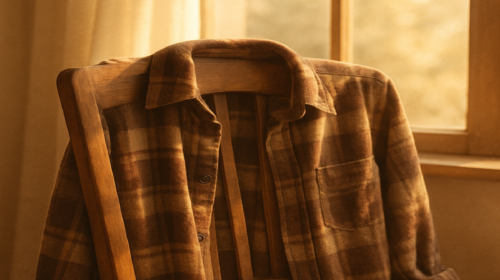Every morning at 7:00 a.m., Mary Peterson would shuffle into the kitchen, wearing the same faded plaid shirt. It hung loosely on her shoulders, the sleeves rolled at the wrists, its once-crisp collar now soft and frayed from years of washing.
It had belonged to her husband, James.
They had been married for 41 years. James passed away quietly in his sleep two years ago—no hospital, no drawn-out illness. Just one breath that never came back. He had worn that same red-and-gray flannel shirt the day they met, the day he proposed, and on countless Sunday mornings when they’d dance slowly in the living room to old records.
After the funeral, Mary kept the shirt. Washed it. Folded it. Then started wearing it. Not for show. Not for attention. Just… because it still felt like him.
Her son, Brian, noticed of course.
At first, he said nothing. Grief makes people do strange things, and he figured she just needed time. But as the months passed—then a year—he grew concerned. Every time he visited, she was wearing it. He would catch her gently rubbing the cuff between her fingers or leaning into it as if the fabric still held his scent.
One chilly November afternoon, Brian dropped by unannounced. He brought lunch and tried to make small talk. But the shirt was there again—like a shadow that wouldn’t leave.
Finally, over soup and sandwiches, he said gently, “Mom, can I ask you something?”
She looked up from her bowl.
“Why do you still wear Dad’s shirt every day?”
Mary didn’t answer right away. Her eyes fell to her hands, fiddling with the button at her wrist.
“I guess it makes me feel like he’s still here,” she said finally. “Like the day he left, he forgot something… and he’ll come back for it.”
Brian swallowed hard. “Mom, I miss him too. But you can’t keep living in the past.”
She smiled sadly. “You think that’s what I’m doing?”
“Aren’t you?”
Mary stood and walked to the living room. She opened a small drawer by the fireplace and took out a folded note. She handed it to him.
It was written in James’s familiar, blocky handwriting:
“If you’re reading this, it means I’m not there anymore to hold your hand. But I hope you’ll let this old shirt do it for me for a while. I wore it on our first date and every time I needed courage. Now, I’m giving it to you—for courage. Wear it on the days when missing me feels too heavy. And when you’re ready to hang it up, I’ll know you’ve found a little peace. No rush. I love you—forever. —James”
Brian stared at the note. His chest tightened as tears welled in his eyes.
“I didn’t wear it because I couldn’t let go,” Mary said softly. “I wore it because he asked me to. It wasn’t about holding on—it was about learning how to live without him… just one day at a time.”
Brian sat back down, the note trembling slightly in his hand.
“I never knew,” he whispered.
Mary chuckled gently. “He slipped it into his nightstand drawer. I found it the day after he passed. Trust your father to keep loving me even when he wasn’t here.”

Later that evening, as they washed dishes together, Brian noticed something different.
She wasn’t wearing the shirt anymore.
Instead, it was folded neatly on the back of the chair beside her—resting quietly, like a guest who no longer needed to be announced but still deserved a place.
A week later, Mary began volunteering at the local library. She wore new clothes—soft sweaters, colorful scarves. She laughed more. She even started baking again.
But on particularly quiet mornings, when the air was cold or the sky was heavy with clouds, she’d pull out that flannel shirt and sit with her coffee by the window. She never spoke when she wore it—never needed to.
Brian would sometimes stop by, see her there, and just sit beside her, watching the trees sway. They didn’t talk much about James on those days. But he was always there—in the air, in the coffee, in the warmth of an old plaid shirt worn with love.
Final Thought:
Grief doesn’t always look like sadness. Sometimes it looks like a well-worn shirt, a quiet ritual, or a note tucked away where no one sees. Love doesn’t end with loss—it reshapes itself, becomes quieter, more patient. Mary’s story reminds us that healing isn’t about forgetting. It’s about honoring the presence of someone who still lives in every thread, every memory, every breath we take forward.



